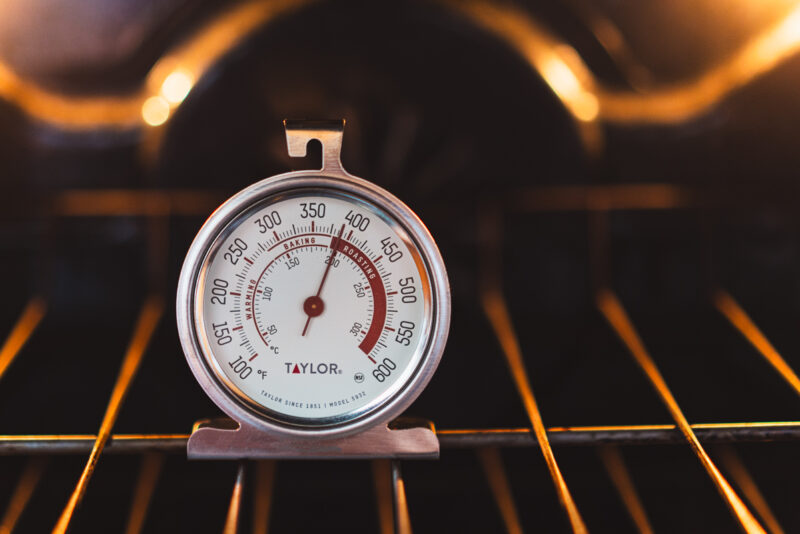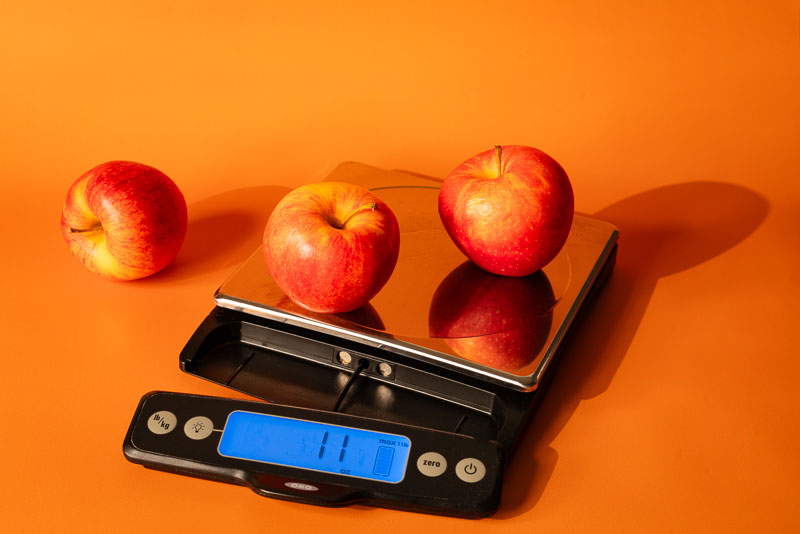Ina Garten, Alton Brown and other culinary pros say you need an instant-read thermometer, oven thermometer, refrigerator thermometer and a kitchen scale for consistent (and safe) cooking. They’re right.
One of the best lessons I learned in culinary school was the importance of measuring accurately for reliably awesome results. And that meant using the right tools.
I used a kitchen scale to weigh ingredients, especially in my pastry classes. I grabbed my instant-read thermometer to gauge when meat was done.
When getting my ServSafe certification, I got acquainted with the “temperature danger zone” (more on that below).
This kind of accuracy isn’t just for people who work in food service. It helps any home cook achieve better results, too. A variety of thermometers and a kitchen scale take the guesswork out of cooking.
Here are four tools I use almost daily.

An oven thermometer helps gauge whether your oven is running hot — or cool.
Oven Thermometer
What is it? An inexpensive tool that lets you monitor your oven’s accuracy.
Why you need it: When Ina Garten told me she always uses an oven thermometer, my ears perked up.
“Every single time I turn on the oven, I check the oven thermometer,” she told me. “I’m obsessed with the temperature of an oven.”
Here’s why Ina Garten always follows a recipe – even her own>>
When a pro like Garten, who has a top-of-the-line kitchen with meticulously maintained equipment, always uses an oven thermometer to ensure the temperature is accurate, you probably should, too.
Ovens do a pretty good job most of the time. But it’s not unusual for them to run a wee bit hot or cool or have hot spots (especially common with gas ovens).
“Every single time I turn on the oven, I check the oven thermometer,” Garten told me. “I’m obsessed with the temperature of an oven.”
If your oven is a little off, you can simply adjust the temperature when you preheat it, or modify the cooking time.
If it’s off by a lot – say, 15 or 20 degrees Fahrenheit – the oven may need recalibrating. Depending on the model, you can do this yourself (check the owner’s manual or manufacturer’s website for instructions). Or call in a technician to do it for you.
Best oven thermometer: Taylor Large Dial Cooking Oven Thermometer ($9)

An instant-read digital thermometer, like the Thermapen One, takes the guesswork out of knowing when food is cooked “just right.”
Instant-Read Thermometer
What is it? A digital probe that’s inserted into food to read the temperature in less than a second.
Why you need it: You’ll see info all over the Internet touting the finger-touch method to gauge the doneness of steak. Basically, that’s comparing the firmness of the pad of your palm to the meat to determine if it’s done. It’s a popular method, but a study of home cooks found it was woefully inaccurate.
Meathead Goldwyn, the man behind AmazingRibs.com, a site devoted to all things barbecue and grilling, says a meat thermometer is a must-have. And no, it’s not just for amateurs.
“Of the thousands of barbecue teams competing for prize money every weekend across the nation, I have never ever seen one that didn’t use a digital meat thermometer,” he notes.
Another of Meathead’s recent posts examines the science behind the common recipe instruction to cook chicken “until the juices run clear.” We need to retire that myth. (Along with washing chicken, which has zero food-safety benefit.)
Cooked chicken with clear juices can be unsafely undercooked or dreadfully overcooked, he says. Chicken with pink juices, and even pink meat and blood at the bone can be perfectly safe to enjoy. It just depends on the bird. A good-quality instant-read thermometer is the best way to ensure chicken (and other meat) is done.
Best instant-read thermometer: I’m a fan of ThermoWorks’ basic Thermapen One digital thermometer. If it’s good enough for Alton Brown, it’s good enough for me! I use it to test the doneness of meat and poultry, of course, but also to check the temperature of water to make bread dough or oil for frying. I love that it turns on automatically when you unfold the probe (and off when you fold it back in). The display also lights up automatically depending on the ambient light.
A note about candy thermometers: You could use the Thermapen One as a candy thermometer – it’s got the range to handle high temperatures. However, if you do a lot of candy making or deep frying, a large candy thermometer that clips to the side a pot is more convenient to keep an eye on how hot things are as they cook.
How to Remodel a Kitchen In Nine Days >>

Stashing a thermometer in the refrigerator helps ensure food stays cold but not frozen — or creeping up into the temperature danger zone.
Refrigerator Thermometer
What is it? Just like it sounds – a thermometer that lives in the fridge to help you monitor how cold it is. You can stash one in the freezer as well to keep tabs on the temperature there.
Why you need it: If your refrigerator feels cold, all good, right? Not necessarily.
Refrigerated fare should be kept at 33°F-40°F. When the temperature rises above 40°F, it enters the temperature danger zone (41°F-140°F), which is a breeding ground for harmful bacteria. When the fridge runs too cold, well, you’re not looking to freeze your food there.
Without a thermometer to verify the temperature, you’re unlikely to notice the difference of a few degrees.
Also, how empty or full your refrigerator is can make a big difference in how cold it runs. The sweet spot is a fridge that’s about three-quarters full. There’s enough cold food and air circulation to help keep the refrigerator cold overall so it runs efficiently. You may find you can dial the fridge down a bit.
An overfull or empty fridge has work harder to stay cold, and you might have to dial it up.
Best refrigerator thermometer: Taylor Large Dial Refrigerator and Freezer Kitchen Analog Thermometer ($9)
Trend watch: Frozen food is cool again>>

A kitchen scale helps both accuracy-obsessed bakers and lazy cooks.
Kitchen Scale
What is it? Whether it’s an old-school analog or new-school digital model, a kitchen scale makes it easy to portion ingredients for accurate results.
Why you need it: Years ago, a co-worker used my inherent laziness to persuade me that I needed a kitchen scale.
“I dunno,” I whined. “I mean, sure, if you’re a pastry chef or an avid baker …”
“Alison,” she replied, “using a scale is so much easier than using measuring cups. You just dump the stuff in – if you have to much take some out. If there’s not enough, add more. And you can zero it to keep adding ingredients to the same bowl.”
I was sold, and have relied on my kitchen scale ever since.
See how easy a kitchen scale makes baking this apple cake recipe>>
My love of a kitchen scale grew in culinary school, where I learned it’s the key to consistently excellent baked goods. Using measuring cups is cumbersome and not really accurate. For example, if you scoop your measuring cup into the flour, you’re likely using too much, which makes baked goods dense.
Measuring by weight is common in other countries. I’m thrilled to see more American cookbooks and websites doing the same.
Best digital kitchen scale: I’m a longtime fan of Oxo’s 11 lb Stainless Steel Food Scale with Pullout Display ($56). It has a light-up, pull-out display, you can zero it to weigh more ingredients (nice for baking), and it’s easy to switch between imperial and metric weight. Even better, it’s easy to clean because you can remove the platform to wipe it down. It’s also slim enough to slip into a kitchen drawer when I’m not using it. (NOTE: The scale pictured here is my older-model Oxo. The current model has all the same features with a sleeker display.)
